
The Concerned Citizens of Mendota (CCOM) is a group of residential and commercial property owners who along with residents and those doing business in the City of Mendota, represent a concerned and collective group when it comes to monitoring and responding to how the EPA soils remediation project is being conducted at the Black Brothers location at the corners of 5th Street and 9th Avenue. CCOM was created by Darryl Cotton who’s family has, for 3 generations, lived and grown up in Mendato with Darryl’s father Dale currently owning some 70 properties within the City of Mendato. Darryl has been in contact with Bernie Anderson, Regional Manager, Community Affairs with Nicor to help get community answers to questions that will be posed on this website.
The activities being performed on this project are being overseen by the Illinois Environmental Protection Agency. The project cleanup is being done under a joint venture relationship with Commonwealth Edison (ComEd) and Nicor Gas (Nicor). They have created a website that will tell the public what the scope and extent of the project is and where to get additional information regarding project conditions, soils sampling levels and locations, what chemicals have been found and what remediation efforts for soil, air and water have been undertaken with an eye on where these efforts will continue to proceed. The following information comes directly from the Nicor and ComEd Mendota Toxic Waste Cleanup Website. We strongly encourage those visiting this CCOM portal to thoroughly investigate the Nicor/ComEd website as a way to get a better understanding of what this Manufactured Gas Plant (MGP) project entails.
Nicor Gas and ComEd (the Utilities) are conducting an environmental cleanup project at the location of a former MGP in Mendota, Illinois. From 1875 until 1941 the MGP manufactured gas from coal, coke and/or oil to serve the community’s energy needs. The Mendota MGP was located at 501 9th Avenue in Mendota, Illinois, on property currently owned by The Black Bros. Co.
This portal will be constantly updated as information becomes available and posted in a chronological fashion. What you see one day may be expanded upon, corrected or even removed as more information becomes available. When dealing with a project of this magnitude, knowledge really is power folks so KEEP COMING BACK!
1.0) Our Mission: To act as a bridge between the information we compile and the Prime Contractor, the Site Owner, the EPA and any and all Subcontractors and Engineers that provide services to the Prime Contractor, hereinafter collectively referred to as “Prime Forces“. We will compile that information from publicly available sources and as requested under the Freedom of Information Act. CCOM will then engage our own professional services Engineers and Authorities to independently determine if the project boundaries as having been established by the Prime Forces are adequately protecting the surrounding areas from any chemicals that were discharged into the environment during the operation and storage of the identified chemicals.
The Mendota manufactured gas plant (MGP) was active from 1875 to 1941 to provide gas for lighting, heating, cooking and later, industrial applications. MGP operations were located on a 2/3-acre site at 501 9th Avenue, southeast of its intersection with 5th Street. The Mendota MGP included gas production and purifier buildings, oil tanks, retort area, tar well, coal storage, two gas holders and the railroad spur line where train cars delivered and retrieved the raw and processed materials required of these MGP activities.
1.1) Prime Forces MGP Investigation Activities: Environmental studies were conducted in areas where historical maps indicated gas production had taken place. The studies found remnants of MGP structures below ground and have confirmed the presence of MGP-related residuals in soil and shallow groundwater. Various volatile organic compounds (VOCs), polycyclic aromatic hydrocarbons (PAHs), metals and other inorganic materials were detected in soil and groundwater.
1.2.1) Who is Paying for This Work?: This project is part of an EPA fund under their Inventory No 0990555005. It is work being conducted in cooperation with, and with oversight from, the Illinois Environmental Protection Agency (Illinois EPA) through it’s Illinois EPA Voluntary Site Remediation Program (SRP). The SRP cleanup program provides Remediation Applicants (i.e., any persons seeking to perform investigative or remedial activities) the opportunity to receive IEPA review, technical assistance and No Further Remediation determinations from the Illinois EPA. This program is designed to be flexible and responsive to the needs of the Remediation Applicants as in the Prime Forces. The goals and scope of actions at these sites are normally defined by the Remediation Applicants.
The Illinois EPA is authorized to issue No Further Remediation (NFR) letters to the Remedial Applicants who have successfully demonstrated, through proper investigation and, when warranted, remedial action, that environmental conditions at their remediation site do not present a significant risk to human health or the environment. The NFR letter signifies a release from further responsibilities under the Illinois Environmental Protection Act. This program’s activities are paid by the parties requesting the Illinois EPA’s oversight. This means the EPA is being paid by the Prime Forces to determine scope and testing locations. When the Prime Forces request an NFR letter the EPA will send it to the party(s) requesting it thereby relieving the Prime Forces of all future liability for conditions that have not, in some cases, even been determined through air/soil/water testing of those sites. CCOM is not content with that arrangement and as a minimum will act as a watchdog on how these NFR letters are processed and employ independent engineering and testing services to corroborate those findings.
1.2.2) CCOM Email correspondence:
1.2.2) 09/24-09/28/20 Cotton and Timms Emails CCOM spurred from these series of emails. After visiting the Graves-Humes Public Library in Mendota to see all the hard copy files that were made available to the public, Cotton was directed to an area where approximately 15 binders were staged for anyone interested in reviewing the information. The librarian told Cotton that he was the first one to ever ask to see these files.
After a review of the documents on file which to his discovery began documentation in 2012 but in his review only included a Prime Forces soil sampling from 2018. Based on that Cotton, in this email asked Timms if there were more recent tests that could be provided and he wanted spot testing of the soils outside the areas defined by the Prime Forces. As you can see in his reply that was not to be. Essentially Cotton was being told that all is well in those regions outside the Prime Forces defined boundaries and that the Cotton properties will be “expected” to receive an “unrestricted” NFR letter, per the Prime Forces directive, from the EPA, once the remediation work has been completed. The next section includes all the electronic files that we’ve been able to compile that show project data by Year.Month/Date.
1.2.3) Prime Forces Project Data as Correspondence, Public Notices, Documents, Testing and Engineering:
02.05/22: BOL-Reference-Sheet_09905550051-BOL-Reference-Sheet-05222002
03.05/15: BOL-Reference-Sheet-_09905550052-BOL-Reference-Sheet-05152003
11.03/18: Burns-McDonnel-EPA-Application-_09905550055-BurnsMcDonnell-03182011
11.03/22: EPA Enrollment SRP for Nicor_Black Brothers
11.03/28: EPA-to-Nicor-Approval-Letter_09905550057-IEPA-03282011
11.08/08: Nicor-Site-Investigation-and-Work-Plan_099055500524-SIWP-08082011
11.08/20: Nicor-Ambient-Air-Monitoring-Plan_099055500521-SIWP-Ambient-Air-082011
11.08/21: EPA-to-Nicor-Approval-Letter_09905550056-IEPA-08252011
11.10/26: EPA-to-Nicor-Approval-Letter-for-Air-Monitoring_09905550058-IEPA-10262
12.03/15: Test-America-Analytics_-099055500529-Analytical-03152012
12.04/17: Nicor-Supplemental-Site-Investigation-Work-Plan-Phase-II_-_099055500-1
12.04/18: Nicor-Supplemental-Site-Investigation-Work-Plan__099055500522-SSIW-1
12.06/06: EPA-Letter-to-Nicor-re-Project-Scope-and-Technical-Reports_-S0990555005
12.06/19: EPA-Letter-re-Site-Remediation_-09905550059-IEPA
13.03/15: Nicor-Resident-Notification-Letter_-to-099055500510-NICOR-MendotaNotif
13.04/08: Test-America-Analytics_099055500532-Analytical
13.05/01: Nicor-Supplemental-Sampling-Data_099055500531-Supplemental-SI-May-2013
13.05/01: Nicor-Supplemental-Sampling-Data2_099055500530-Supplemental-SI-May-2
15.04/01: Nicor-Offsite-Summary-Report_099055500527-OffsiteSummaryRpt-042015-PropLayou
15.07/21: Nicor-Site-Investigation-Sampling-Data_099055500533-SI-V1_2-072013
15.07/21: Nicor-Site-Investigation-and-Remediation-Objectives Report Volume I of II-099055
15.07/21: Nicor-Site-Investigation-and-Remediation-Objectives-Report_Volume II of II
15.08/27: IEPA-Cleanup-Memorandum_099055500517-IEPA-CleanupObj-08272015
15.08/28: EPA-to-Nicor-Letter-re-Boundary-and-Migration-Issues_099055500520-IEPA
15.08/28: EPA-to-Nicor-Letter-re-Unsatisfactory-Contamination-Levels_099055500518
16.05/06: Nicor-to-EPA-Jeff-Guy-Letter-re-Consultant-Change-099055500516-Nicor-C
18.08/07: Volume 2 of 4 (Part I of II)
18.08/07: Volume 2 of 4 (Part II of II)
18.08/07: Volume 4 of 4 (Part I of II)
18.08/07: Volume 4 of 4 (Part II of II)
18.10/02: EPA-to-CORE-Memorandum_-099055500519-IEPA-Tier2-10022018
18.10/04: EPA-Letter-to-CORE-Group-Jeff-Guy_099055500515-IEPA-CleanUpObjectivesR
18.10/15: EPA-to-Nicor-Approval-Letter_099055500514-IEPA-10152018
18.11/30: Burns-to-EPA-Updated-DRM_-099055500513-BurnsMcDonnell-11302018
19.04/01: Burns-Response-to-EPA-Comments_099055500512-RespToIEPAcomments_RAP-040
19.04/30: EPA-to-Nicor-Approval-Letter_-09905550054-IEPA-04302019
19.10/22: Nicor-Public-Update-Statement-_09905550053-Nicor-10222019-ToMendota
20.03/21: Nicor-Public-Project-Update_0990555005-03312020.pdf
20.10/07: EPA Nicor_EPA -SWAP Map
1.3) Prime Forces MGP Site Cleanup Plan: It is being performed in cooperation with the property owner and the City of Mendota. The Prime Forces developed a cleanup plan to restore the property to current environmental standards. Soil exceeding Illinois EPA standards is excavated, loaded into trucks and disposed of at a licensed waste disposal facility. The excavation is then back filled with clean materials and the property will be restored. Most of the excavation work is conducted under a temporary fabric tent type enclosure that assists with minimizing odors and air emissions. The enclosure operates under negative pressure so the air from within the enclosure is drawn through air purification equipment before being released to the atmosphere.
1.4) Prime Forces Contacts:
1.4) Anderson, Bernie; Nicor Gas Regional Manager, Community Affairs @ 309.261.4155 – Bander3@southernco.com
1.4) Timm, Jay: Illinois EPA @ 217.557.4972 – Jay.timm@illinois.gov
1.4) Conner, Jenessa: Illinois EPA @ 217.524.2084 – Jenessa.N.Conner@
1.5) CCOM Contacts:
1.5) Darryl Cotton, 151 Farms @ 619.954.4447 – Indagrodarryl@gmail.com
2.0) Project Site Map and Area of Remediation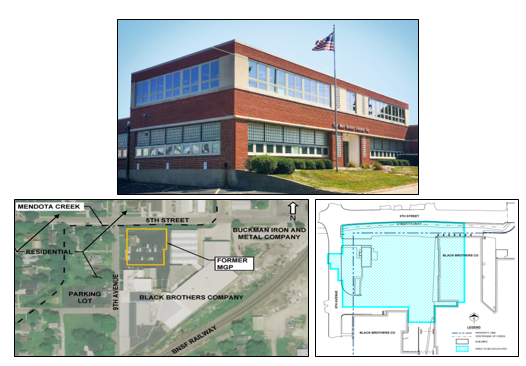
Download 2.0.1 Topographical Map PDF Version Here
Download 2.0.2 Site Remediation Map PDF Version Here
2.1) Prime Forces Defined Project Impact Radius Map
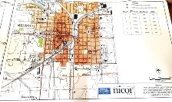
2.1.1) Burns McDonnell creates the drawings that identify the site location and outlying properties that fall within a 1,000 ft. radius of the remediation work. This distance is a preliminary assessment and could be, depending on the conditions, moved beyond that 1,000 ft. region. Of note, why would the original project assessment include a 1,000 ft radius map and then determine that no soils testing will be done outside the immediate area of the MGP site?

2.1.2) This image taken from one of the file folders available for public viewing at the library show the contaminant plume does not go North of the Mendota Creek. They would have you believe that the plume is being contained by the creek. We believe this plume drawing to be a misrepresentation of actual field conditions. We know the creek is 10′ deep from the grade line. Any leakage over the years from the tanks would be available to drop down below the 10 ft mark and leach along lower paths. Based on this drawing there is no accounting for that. This map does not even coincide with their other map in Section 2.2 which clearly shows contaminant levels to the West of 9th Avenue.
Download 2.1.2 PDF Version Here
2.2) Prime Forces Soil Probe Locations Maps
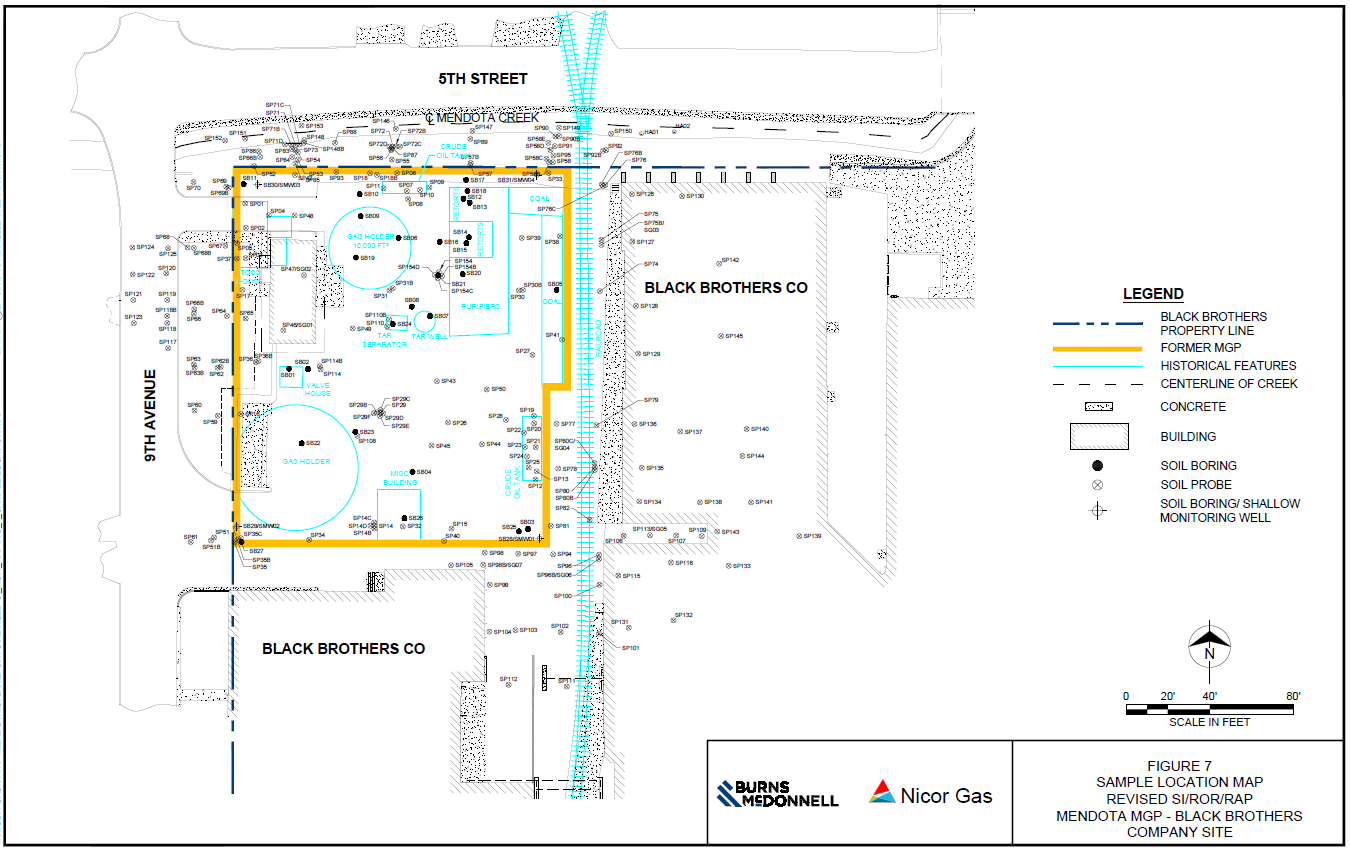
2.2.1) Multiple soil probe test sites can be seen in this map. Of note, there are no test sites shown North of 5th Street.
Download 2.2.1 PDF Version Here
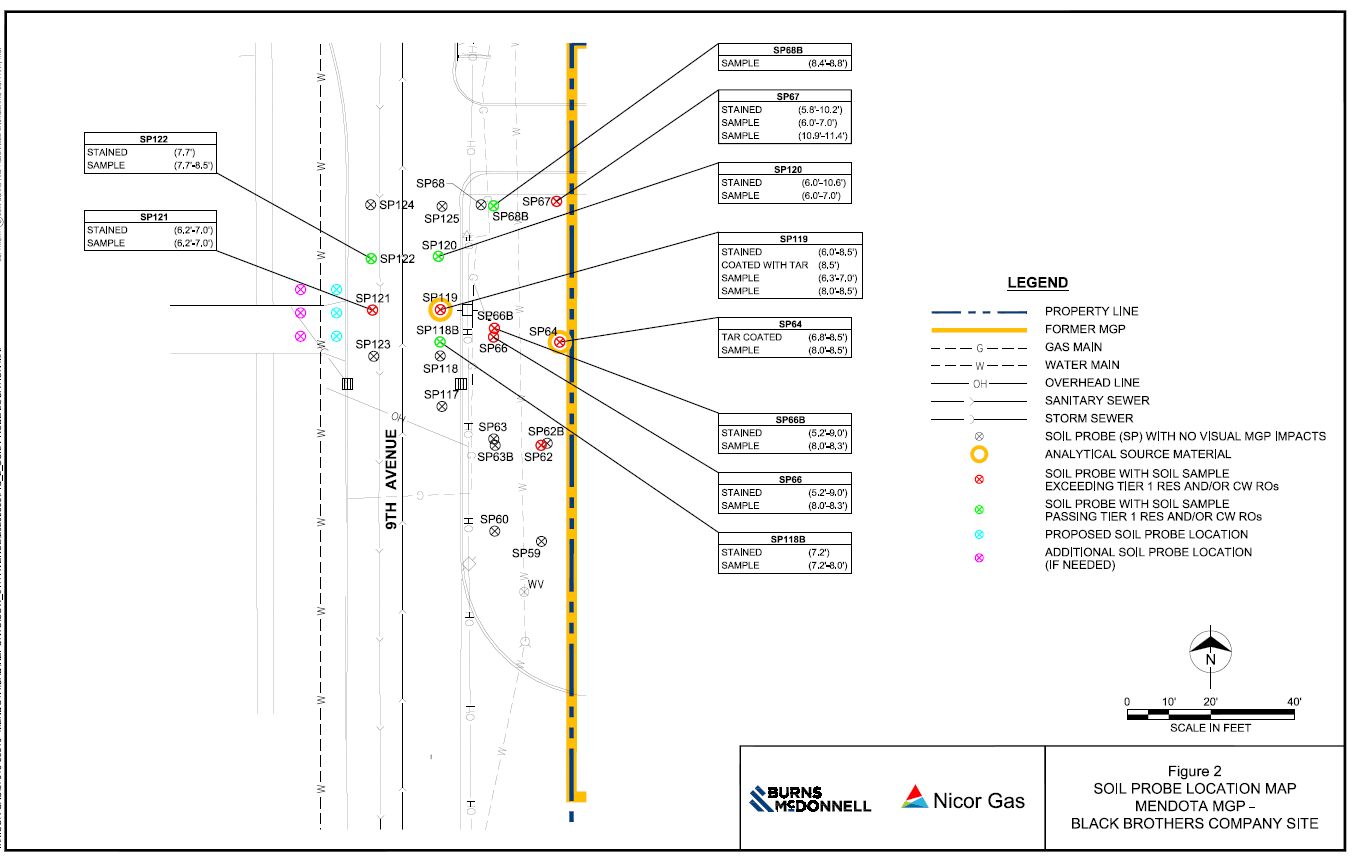
2.2.2) This map represents an expanded view of the soils test area just outside the remediation site boundaries. As can be seen by this image there are contaminant levels due to chemical leaching found to the West of the remediation site work.
Download 2.2.2 PDF Version Here
2.3) 2018 Soils Probe Readings
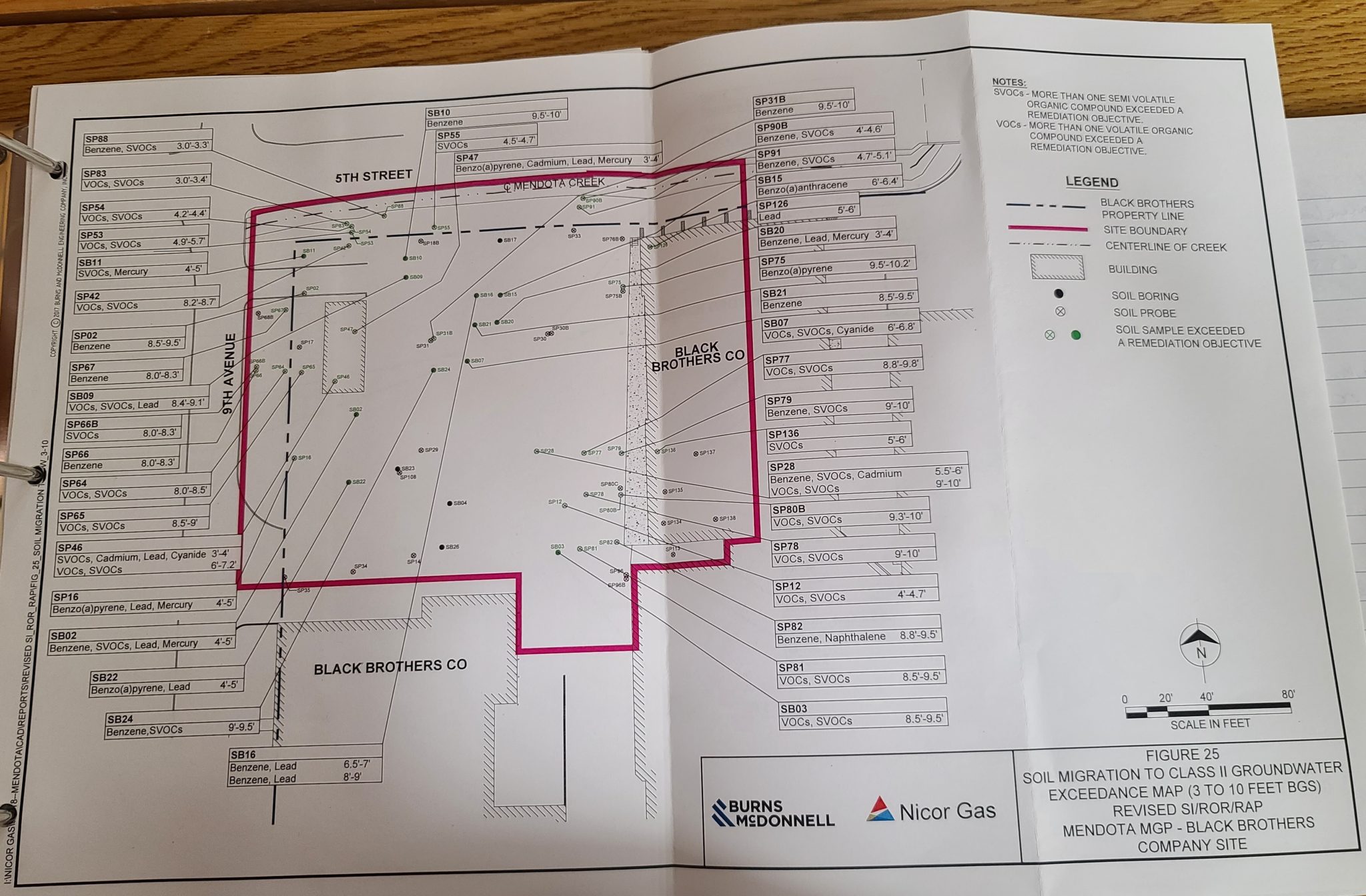
2.3.1) In combination with the readings taken here along with the chemicals being found in Section 2.4, we will be determining on a chemical by chemical basis what the EPA considers a safe level of exposure these are to what was found in the tested soils.
Download 2.3.1 PDF Version Here
2.3.2) The following values will correlate the above 2.3.1 site depth values that exceeded EPA maximum limits. Once the soils readings are made available we will add those values to compare them to the % over the maximum allowances are. Volatile Organic Compounds (VOC’s) and Semi-Organic Compounds (SVOC’s) consist of a number of chemicals that fall within toxicity classes and are given in a range to account for what specific chemicals are found in this class.
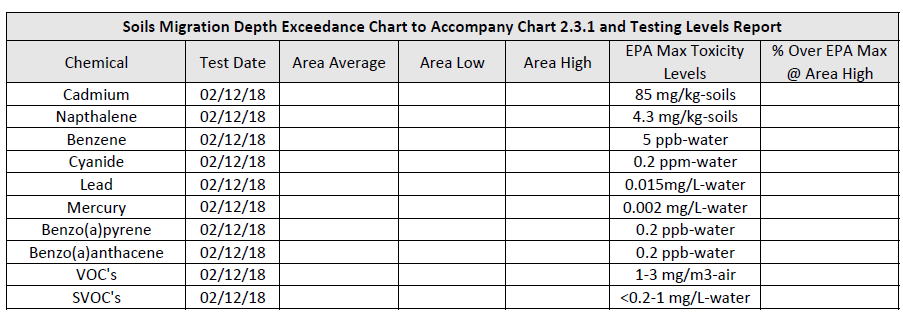
2.4) Identified Site Chemicals and Their Known Individual (Not in Combination with Other Listed Chemicals) Toxicological Effects on Human Health:
Cadmium: Exposure is a risk factor associated with a large number of illnesses including kidney disease, early atherosclerosis, hypertension, and cardiovascular diseases.
Naphthalene: Exposure to large amounts of naphthalene may damage or destroy red blood cells, most commonly in people with the inherited condition known as glucose-6-phosphate dehydrogenase (G6PD) deficiency, which over 400 million people suffer from.
Benzene: The US Department of Health and Human Services (DHHS) classifies benzene as a human carcinogen. In 1948 the American Petroleum Institute (API) stated in that “it is generally considered that the only absolutely safe concentration for benzene is zero”. There is no safe exposure level; even tiny amounts can cause harm as it increases the risk of cancer and other illnesses, and is also a notorious cause of bone marrow failure. Substantial quantities of epidemiologic, clinical, and laboratory data link benzene to aplastic anemia, acute leukemia, bone marrow abnormalities and cardiovascular disease. The specific hematologic malignancies would include: acute myeloid leukemia (AML), aplastic anemia, myelodysplastic syndrome (MDS), acute lymphoblastic leukemia (ALL), and chronic myeloid leukemia (CML).
Benzene’s Human Exposure Toxicological Profile
Cyanide: Is a potentially deadly chemical whereby exposure to even lower levels of cyanide over a long period results in increased blood cyanide levels, which can result in weakness and a variety of symptoms, including permanent paralysis, nervous lesions, hypothyroidism and miscarriages. Other effects include mild liver and kidney damage.
Lead: Lead is a neurotoxin that accumulates in soft tissues and bones; it damages the nervous system and interferes with the function of biological enzymes, causing neurological disorders, such as brain damage and behavioral problems. Lead has no confirmed biological role, and there is no confirmed safe level of lead exposure. A 2009 Canadian–American study concluded that even at levels that are considered to pose little to no risk, lead may cause “adverse mental health outcomes”.
Mercury: Mercury and most of its compounds are extremely toxic and must be handled with care; in cases of spills involving mercury specific cleaning procedures are used to avoid exposure and contain the spill. Toxic effects include damage to the brain, kidneys and lungs. Mercury poisoning can result in several diseases, including acrodynia (pink disease), Hunter-Russell syndrome, and Minamata disease.
Benzo(a)pyrene: BaP’s metabolites are mutagenic and highly carcinogenic, and it is listed as a Group 1 carcinogen by the IARC. BaP has an effect on the number of white blood cells, inhibiting some of them from differentiating into macrophages, the body’s first line of defense to fight infections. In experiments with male rats, sub-chronic exposure to inhaled BaP has been shown to generally reduce the function of testicles and epididymis with lower sex steroid/testosterone production and sperm production. A link between vitamin A deficiency and emphysema in smokers was described in 2005 to be due to BaP, which induces vitamin A deficiency in rats. A 1996 study provided molecular evidence linking components in tobacco smoke to lung cancer. BaP was shown to cause genetic damage in lung cells that was identical to the damage observed in the DNA of most malignant lung tumours.
Benzo(a)anthracene: It is produced during incomplete combustion of organic matter and is one of carcinogenic constituents of tobacco smoke.
3.0) Public Documentation Files All City of Mendota meeting and hearing minutes along with any correspondence that would have had anything to do with MGP Site Remediation Work.
4.0) Our Questions This area is designed to allow us to post our questions to the Prime Forces. As answers are given we will post them in brackets that identify the source answers as well.
4.1) What materials were the underground tanks constructed of? (CCOM Responds) We believe they were single wall steel tanks that once rusted allowed any materials to flow out of the containment tanks and into the surrounding areas. Unlike underground storage tanks today there were no backup containment tanks that should the inner tank be breached sensors would alarm the operators of a leak and remedial action could be taken.
4.2) How deep did the tanks go below grade? (CCOM Responds) The depth of these tanks is important to know. For one reason is that the depth of the creek is believed to be 10′ below surface grade. We would want to confirm that but for the purposes of this answer, any tank that had a bottom deeper than the neighboring creek would put the leaking materials past the creek as the water would not carry those chemicals North of the project site.
4.3.1) How likely is it that these chemicals made it into our drinking water?
4.3.2) If these chemicals entered into our water supplies what type of monitoring is being done and where are the results for that monitoring?
4.4.1) How likely is that these chemicals made it into our air supply?
4.4.2) If these chemicals have become airborne what type of monitoring is being done and where are the results for that monitoring?
4.5.1) Were the tank failures considered catastrophic?
4.5.2) Why were the MGP operations stopped?
4.5.3) Did the tank failures have anything to do with the cessation of MGP operations?
4.5.4) Where are the images of the tanks once they were exposed?
4.5.5) What is the estimated amount of raw and processed materials that went through this location over the lifetime of its operation?
4.5.6) Were there any remediation or materials removal processes done between 1941 and the beginning of this project? If so what were they and are they documented? If so where are those documents now?
4.5.7) When did it come to the local and state governments attention that these leaking toxic chemicals represented a threat to the community?
4.6.1) What, if any, were the environmental impacts from the railroad car operations that served the MGP site
4.6.2) Are any tests being conducted to see if there have been any environment impacts along the railway spur that serviced the MGP?
4.7) We have heard that there are a 3 step contingency plan in place if it’s determined that the soils contamination goes beyond the Prime Forces expected contaminant regions. Could you tell us what those contingency plans are?
4.8) Could you tell us exactly how this project is being funded?
4.9.1) From the standpoint of how close the residents and the neighboring creek are to the MGP site is this an unusual project?
4.9.2) If this is not an unusual project can you identify other MGP projects that have been completed where similar conditions existed?
4.10.1) Are you aware of any claims that have been made by parties who believe they have suffered physically from the chemicals that were leached off this site?
4.10.2) If there have been any claims based on the MGP site operations how were they resolved?
4.11.1) Where does the remediated soil go when it leaves the MGP site? If there is more than one site please provide us a list of all sites.
4.11.2) What methods are being employed to assure that the removed soils will not pollute the new areas where it is being exported to?
